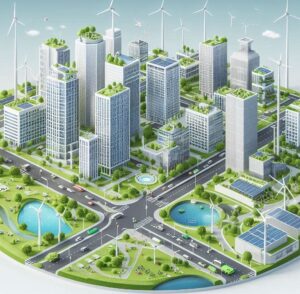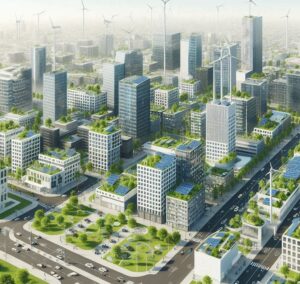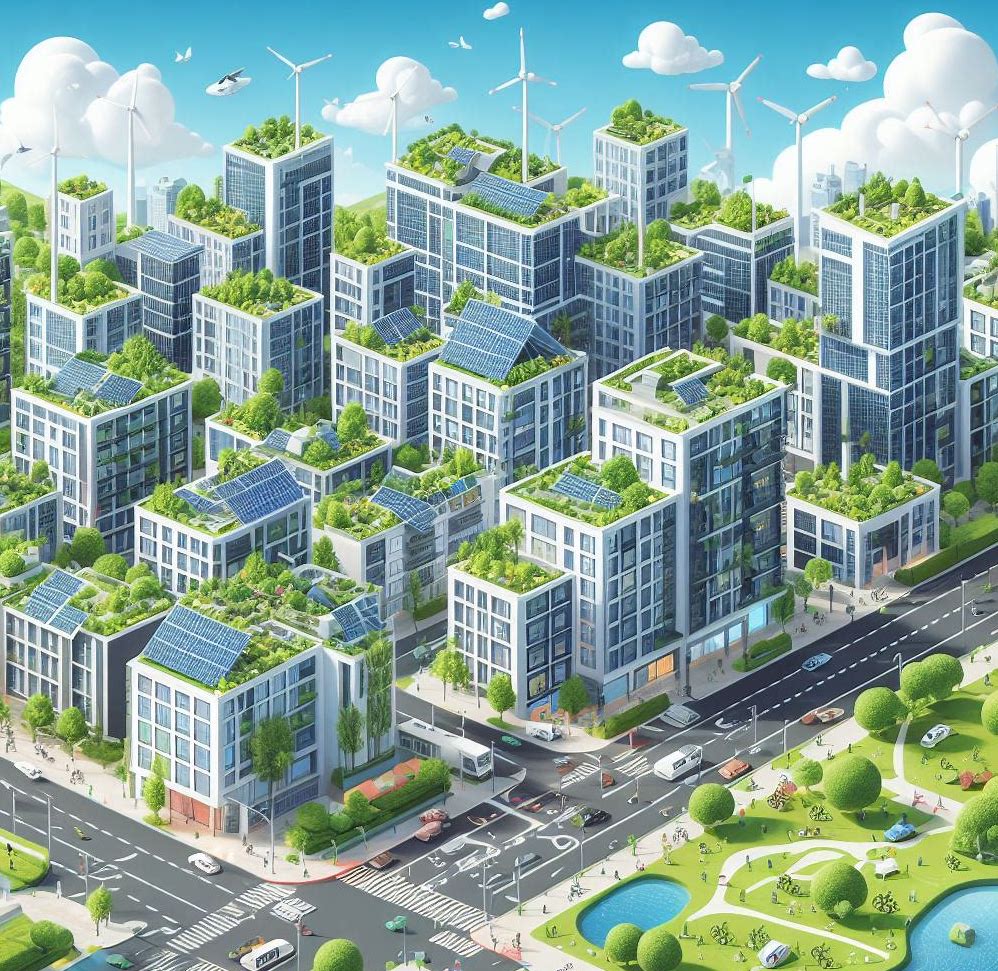The Imperative for Renewable Energy in Urban Growth

As the urban landscape continuously expands year after year, the need for energy in these bustling cities grows at an unparalleled pace. Currently, these bustling urban hubs are accountable for nearly two-thirds of the world’s total energy consumption. This disproportionate reliance on energy can primarily be attributed to urban lifestyle activities, industrial growth, and transportation needs.
The energy fueling these activities is overwhelmingly sourced from traditional, non-renewable sources such as coal, oil, and natural gas. While these energy sources have undeniably fueled economic growth and development for centuries, they pose significant environmental concerns. The combustion of these fuels results in the emission of greenhouse gases, primarily carbon dioxide, which contribute to global warming and climate change. Additionally, these emissions include harmful pollutants like nitrogen oxides, sulfur dioxide, and particulate matter, gravely affecting air quality.
The direct impact of such pollution on public health is becoming increasingly apparent. Urban dwellers often confront health issues such as respiratory ailments, heart disease, and even premature death. Children, the elderly, and those with pre-existing conditions are particularly vulnerable.
Incorporating renewable energy solutions into these densely populated areas is no longer just an option but has become a necessity. Renewable energy sources, including solar, wind, and hydro, can provide cleaner, greener alternatives to fossil fuel-based energy generation. They offer a path to meet the increasing energy demand in cities while decreasing greenhouse gas emissions and air pollutants. This approach not only presents an opportunity to mitigate the adverse effects of climate change but also to improve the health outcomes for millions of city dwellers.
The integration of renewable energy into urban growth strategies is moving from a progressive concept to an urgent imperatif. By prioritising this approach, cities worldwide can harness sustainable development’s triple benefits: strengthening economic growth, enhancing liveability, and protecting the environment.
Exploring Various Renewable Energy Solutions
To combat these challenges, many cities are turning towards a myriad of renewable energy solutions:
Solar: cities worldwide have begun harnessing the power of the sun. This is seen in the deployment of solar panels on rooftops, buildings, and public spaces. The benefits are twofold – it contributes to the city’s energy needs and reduces the strain on national power grids.
Wind: mini wind turbines are another innovative entrant to the urban energy scenario. While massive wind farms have their limitations in urban areas, smaller turbines can be integrated into the city infrastructure.
Geothermal: while less common, geothermal installations, which provide heating and cooling from the constant temperature beneath the Earth’s surface, hold immense potential.
Bioenergy: the collection and processing of waste for conversion into renewable gas add another angle to urban renewable energy strategies.
Cities Successfully Implementing Renewable Energy Solutions
Several cities around the globe are already making striking progress in the energy transition, serving as inspiring examples of what is achievable. These pathfinder cities have put into practice energy goals focused on renewable sources, providing tangible models for other urban areas to emulate.
Consider the stunning example of Denmark’s capital, Copenhagen. This city has pledged to become entirely carbon-neutral by the year 2025, which is an unparalleled commitment among major global cities. Achieving this objective will mean that the city produces no more carbon dioxide than it can offset, ultimately aiming for a net-zero carbon footprint. The principal driving force behind this aspiration is wind energy. Copenhagen is effectively utilising its geographical location, harnessing the North Sea’s strong winds with an array of wind turbines, both onshore and offshore. Not only does this drastically cut down on their carbon emissions, but the wind power industry also creates several job opportunities, boosting the city’s economy.
Masdar City, located in the United Arab Emirates, displays another equally impressive commitment to renewable energy. Unlike Copenhagen, which is transforming a centuries-old city, Masdar City began as a planned city explicitly designed to be a model of urban sustainability. From the outset, renewable energy has been core to its design, drawing power from various clean energy resources. The city has a significant solar power plant, along with numerous rooftop solar installations, providing abundant solar-generated electricity. Other renewable technologies are also present, such as wind towers for natural cooling and water desalination plants powered by renewable energy. Vertical farms and other green spaces also contribute by absorbing carbon dioxide and producing local, organic food for the inhabitants.
The success stories of Copenhagen and Masdar City demonstrate the potential of integrating renewable energy solutions into urban environments. They highlight the fact that transitioning to renewable energy does not just entail environmental benefits but can also include economic and social advantages. From creating a healthier environment to job creation and driving innovative technologies, these cities spotlight the multi-faceted possibility of renewable energy. Their notable progress signals a beacon of hope for other cities, underlining that the widespread adoption of renewable energy is not only feasible but can be beneficial in numerous ways.
Policies to Foster Renewable Energy Integration in Urban Areas

To support the imperative switch to renewable energy in urban locations, active participation from all levels of government is necessary. From local to regional and national levels, government involvement can considerably amplify the transition towards clean energy through a range of policy instruments.
One such instrument is legislation that fosters renewable energy use. Governments can establish laws that mandate the fraction of energy generated or consumed from renewables or set targets for reduction in greenhouse gas emissions, thus encouraging the shift to renewable energy sources. They can also introduce regulations that streamline the permitting process for renewable energy installations, making it easier and more attractive for businesses and residents to adopt renewable energy systems.
Tax incentives represent another significant policy tool. For instance, tax credits, deductions, and exemptions for renewable energy projects can help reduce the capital cost and improve the economic feasibility of these ventures. These incentives encourage private sector involvement, leading to a broader spread of renewable energy.
Subsidies, grants, and low-interest loans for renewable energy can further reduce the upfront costs associated with the installation of renewable energy systems. Feed-in tariffs or power purchase agreements that ensure a fixed remuneration for renewable energy generated over a certain period can also provide financial stability and encourage investment in renewable energy projects.
Governments can invest in new grid infrastructure that can accommodate renewable energy. Modern grid design can facilitate the integration of decentralized renewable energy sources, accommodate energy storage systems, and incorporate smart grid technologies that allow more efficient use and distribution of electricity.
Urban planning is another crucial aspect of fostering renewable energy in cities. Incorporating renewable energy strategies into urban planning and development can lead to the creation of energy-efficient city layouts, the integration of solar and wind energy installations in buildings, and the development of public transport systems powered by clean energy.
The concept of ‘smart cities’ offers another avenue for the inclusion of renewable energy solutions. By harnessing the power of digital technologies to manage urban infrastructure and resources efficiently, cities can incorporate renewable energy into their mechanisms more seamlessly by analyzing energy consumption patterns, improving demand forecasting, and optimizing renewable energy use.
All these measures, collectively, can create a conducive environment for the expansion and deep integration of renewable energy in our cities. Not only will it alleviate the environmental impact of non-renewable energy consumption, but it will also sustain the growth and development of our urban areas in a more sustainable and cleaner way.
In the future, renewable energy technology will play a vital role in urban landscapes. With advancements in tech, the efficiency of renewable energy resources will only improve, opening doors for increased adoption worldwide. The future will also bring its set of challenges, but with planning and innovation, renewable energy can flourish in our cities.

